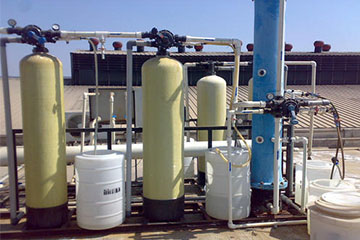DM Plants
DM Plants
For many laboratory and industrial applications, high-purity water which is essentially free form ionic contaminants is required. Water of this quality can be Produced by deionization.
The two most common types of deionization are:
- Two-bed deionization
- Mixed-bed deionization

Purpose: DM (Demineralization) plants remove dissolved minerals, salts, and impurities from water using ion exchange technology, producing high-purity water for industrial, laboratory, and power plant applications.
Process: The plant uses cation and anion exchange resins to remove ions like calcium, magnesium, and chloride, ensuring the water is free from dissolved minerals that could cause scaling, corrosion, or affect product quality.
Two-bed Deionization:
Two-bed deionization is a water treatment process that uses two separate ion exchange beds to remove dissolved minerals and salts from water. The first bed contains cation exchange resin, which removes positively charged ions such as calcium, magnesium, and sodium, while the second bed contains anion exchange resin, which removes negatively charged ions like chloride, sulfate, and bicarbonates. The water passes sequentially through both beds, ensuring the complete removal of dissolved salts and minerals, resulting in high-purity deionized water. This method is commonly used in applications that require water with very low mineral content, such as in laboratories, power plants, and certain industrial processes.
Mixed-bed Deionization:
Mixed-bed deionization is a water treatment process where both cation and anion exchange resins are mixed together in a single bed. This system removes both positively charged ions (like calcium and magnesium) and negatively charged ions (like chloride and sulfate) simultaneously, resulting in highly purified water. As the water flows through the mixed resin bed, the ions are exchanged with hydrogen and hydroxide ions, producing deionized water. Mixed-bed deionization is typically used when ultra-pure water is required, such as in pharmaceutical, laboratory, or semiconductor manufacturing processes, as it provides more efficient ion removal compared to separate bed deionization systems.
Application:
- Foundries
- Food & Beverages
- Pharmaceuticals
- Cosmetics Industries
- Paper & Pulp Industry
